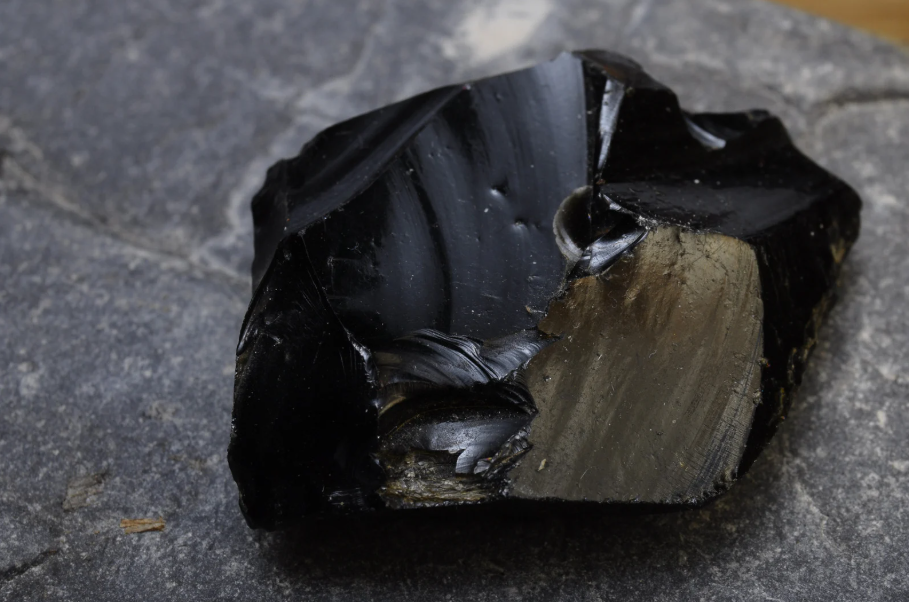
Obsidian's Story
Share

Walk with me among the volcanoes.
The Earth rumbles with subterranean thunder. Bright lava streaks down the mountainside, carving fiery veins into the rock. This lava spits and sputters; it sends pieces of itself flying through hot air. The scent of sulfur and ash permeates like pungent incense. The ground itself is alive.
This is the birthplace of obsidian. The black stone, whose blackness is deep and rich like ink, can only emerge from lava flow. Obsidian in general is ancient—it calls back to the volcanic infancy of the Earth. It also remembers the early days of the human species, for we have long communed with it and used it in work and war.
Walk with me, and I’ll show you obsidian’s story.

Geology
Did you know that obsidian is not technically a crystal? Rather, it is a volcanic glass that forms when viscous lava cools rapidly (when it is flying through the air, for instance). When lava erupts close to the surface where the pressure is low, volatile water may escape and increase the viscosity of the melt. This causes the lava to solidify as glass.
There are many types of igneous rock, but obsidian is distinct. It bears a glassy lustre and is slightly harder than a windowpane. Its conchoidal fracture is reminiscent of quartz, as is the stone’s high silica content (between 65%-85%). A few well-known locations where obsidian abundantly occurs are Mount Hekla in Iceland, the Eolie Islands off the coast of Italy, and Obsidian Cliff in Yellowstone National Park, Wyoming, US. It therefore cultivates a global presence: anywhere you find volcanoes, you will likely find obsidian.
On occasion, crystalline inclusions like magnetite, hematite, or cristobalite may be present within the obsidian, causing variations like snowflake obsidian, mahogany obsidian, rainbow obsidian, or gold/silver sheen obsidian. Each variation creates its own ethereal effect. Snowflake obsidian makes one think of midnight snowfall, for example. Rainbow obsidian shows us a bright sheen of color hiding in the shadows. When you turn the stone and find the right angle, these colors burst forth from the black.
History
The conchoidal fracture of obsidian lends itself to knapping, which is the practice of shaping a stone by striking it with another object. Because of its fracture and the extremely sharp edges that can be made with it, obsidian has been used in a variety of human applications for tens of thousands of years. Many early peoples (including the Aztecs, the Mayans, the ancient Greeks, and more) used obsidian to create tools, weapons, and ornaments. A number of these remnants of early civilizations were dated from hydration rinds that collect on the objects’ exposed surfaces over time.
Obsidian is considered by some to be the stone of the Aztecs and Mayans. This is because the stone was incredibly abundant in this part of the world, leading the people there to use it for nearly everything. Beyond the usual application of obsidian in spears, arrows, knives, and utensils, the Aztecs also polished flat sheets of the stone into scrying mirrors. (The ancient Greeks used obsidian mirrors, too.) Obsidian was worth more than gold here. It was enmeshed in people’s daily lives.
Today, the ultra fine cutting edge of obsidian continues to be useful. There are times during surgical procedures when a standard scalpel is not sharp enough, and an obsidian blade is needed. For example, obsidian is frequently used for procedures involving parts of the body that have thin or delicate skin (such as the eyelids).
People in today’s world also revere the stone for its beauty and metaphysical properties. Many believe obsidian to be a protective and grounding stone that shields one from negativity.

Obsidian is my favorite stone. It has captured my attention for many years, with its pure blackness and glossy sheen. I wear it, I collect it, and I display it. Like many ancient peoples, I use an obsidian mirror for scrying.
For some reason, no matter how many different rocks and crystals I interact with, I always come back to obsidian. Is it the inky depths that recall the perfect darkness of underground Earth? Is it the story of the lava flow that travelled over eons from the planet’s molten heart to break free into the sky?
I don’t know. All I know is I love to get lost in those shadows.


